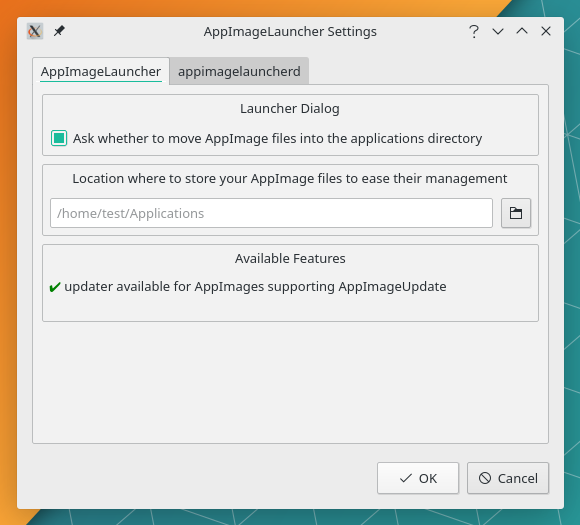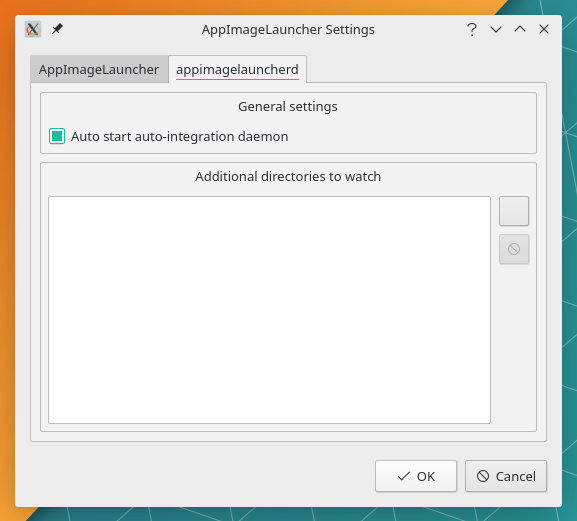On Friday, October 18, AppImageLauncher 2.0.0 was released. This version is the first one to feature libappimage 1.0.0.
AppImageLauncher 2.0.0 provides new, innovative features and subtle improvements over the previous 1.x series of releases. Read on to see what’s changed!
The last release 1.5.0 has been published in August. Right after its release, we switched to libappimage 1.0, and started testing the new version. As expected, there were quite a few bugs in the new, not too well tested yet libappimage code, which have been fixed in the time between the releases.
But there’s also a lot of new features in this new AppImageLauncher version. First and foremost, there are plans to send the really old and pretty much unmaintained appimaged. AppImageLauncher’s own integration daemon called appimagelauncherd received features to allow former appimaged users to transition to using AppImageLauncher through additional configuration options. These features have been added in a single week, actually.
New features
appimagelauncherd received a configuration setting allowing users to add additional directories to monitor for AppImages. AppImages inside those directories will be integrated automatically, i.e., they’ll show up in your application launcher menu just like all other applications and the ones in your central ~/Applications directory. When changes are detected (such as, a file is deleted or a new AppImage is moved inside), the daemon will handle the situation accordingly.
Users of appimaged can make use of this feature by adding the directories appimaged used to monitor for them (and which they actually need). Other than appimaged, AppImageLauncher also allows for adding additional directories. appimaged hardcoded a set of directories, which brought a lot of problems with it (e.g., ~/Downloads was one of those directories, and on a regular computer this directory can be quite large, which causes a lot of overhead as all these files have to be checked on every boot, delaying the boot as well; also, most people don’t necessarily want their AppImages to be scattered across such a directory, without a good way to manage them centrally, which is why AppImageLauncher was created in the first place).
But there’s more to see. A very unique feature has been added that appimaged has never implemented. AppImageLauncher can now automatically recognize filesystems mounted on your computer (non-tech-speak: HDDs, SSDs, USB pendrives, SD cards etc. that you plugged into your computer) and monitor them automatically for AppImages. This might be useful for scenarios where you’d want to put your apps and data on the same removable drive, and take them with you to use them on different computers.
Now this option has some security implications and isn’t switched on by default nor can be configured in the settings dialog. You can switch the option on in the configuration file ~/.config/appimagelauncher.cfg. Search for the [appimagelauncherd] setting and uncomment or add the option monitor_mounted_filesystems = true. Please note that this option is experimental and therefore should only be used by advanced users who understand the implications. The option was suggested by @probonopd, the original author of appimaged, and we’re looking forward to his feedback.
Settings GUI
Talking about the settings dialog, it received a little redesign as well. As there are more options now, they were split into tabs for AppImageLauncher and appimagelauncherd. All new settings but the one about monitoring mounted filesystems, which is hidden intentionally, are available there as well as in the configuration file.
(the Downloads directory was added to the list to demonstrate the new feature)
Conclusion
All these changes and innovations required quite some work. In AppImageLauncher alone, there were 135 commits made since the last release.
> git rev-list --count v1.5.0..v2.0.0
135
This week, a majority of the work was done, and I’m pretty happy with the result. The new AppImageLauncher is the best and most feature loaded one produced so far. And there’s already a version 2.1 planned, with more awesome features to improve your personal AppImage user experience on the Linux desktop.
Where to get the new AppImageLauncher
You can download up-to-date binaries for all platforms supported upstream (Debian and some RPM based distributions with the classic AppImageLauncher, almost any somewhat recent distribution with AppImageLauncher Lite) from the GitHub release page.
If you encounter any issues, please don’t hesitate to open an issue on GitHub. This is the only way we, the developers, get a chance to analyze the problem and eventually provide a fix. Posting your problems in some distribution specific forums is not very useful, since we can’t monitor them all. So, please, consider posting your issue on GitHub, if you find any. Also, you can create issues for feature proposals there.


